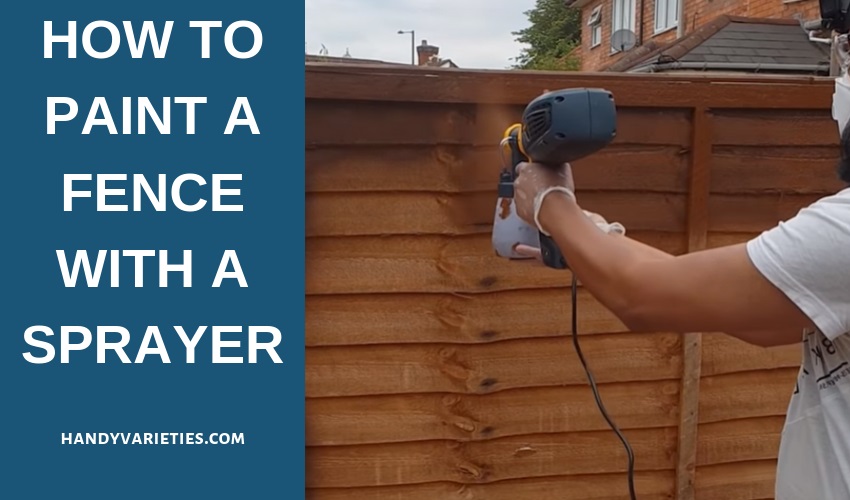Fences are the first thing people notice about your house while visiting. Even just passing by random strangers create a preconceived notion of you depending on your upkeep of the fence. A painted sturdy fence gives a completely different message from that of an old rundown fence. Why keep your old fence in shambles when you can make it as good as new with just a coat of paint?
And here comes the question of the method of painting. Rollers or sprayers? Compared to rollers, paint sprayers have a greater coverage and flawless finish with less time and effort. Simply, they are the more logical choice for efficient and effective painting. Therefore, painting the fence with a sprayer will give you a professional result, saving a lots of time and effort.
Prepping
Professional painters call the process of scraping, cleaning and covering for paint jobs “prepping.” You need to take the preparations seriously for a good result.
- Best time for outdoor painting is summer, as the temperature and humidity remains moderate. Too much heat dries paint quickly without soaking the surface and too cold temperature takes time to dry paint and attract bugs and dirt in the meantime. Also, avoid windy days to prevent paint drifting into unwanted areas.
- Remove grass and plants growing near and around the fence to keep the paint off from spraying. Spread plastic on the ground under the fence to protect the lawn. Move any outdoor furniture away from the surrounding area and allow plenty enough space for your tools and equipment.
- Cover all nearby shrubs, bushes, plants or surfaces you want to protect with large plastic tarps to prevent from overspray. Use painter’s tape to keep paint out of ornament, latches, handles and other hardware. Let your neighbor know about spraying and take permission if you need access to their yard. Be sure to protect their items, landscaping and house the same way.
- Remove all loose nails and screws and use a brush to remove any dust, cobwebs or debris from the surface. If you are repainting, scrape off any loose peeling or chipping paint with a paint scraper. To avoid rough areas or splinters, rub the fence with sandpaper and smooth the whole surface. Wash the fence thoroughly with a pressure washer and cleaning solution and allow the fence to dry completely before painting.
Safety Precautions
Sprayers operate under very high pressure, so simple directing the paint sprayer at exposed skin can penetrate the top layer of skin even if there is no visible cut or scrape. To avoid such tragic happenings, wear lightweight coveralls, a spray hood, safety goggles, and masks. In case of having allergies or severe health problems, wear a respirator to avoid inhaling the fumes and paint particles. Remember safety always comes first.
Setting up the Sprayer
There are different sprayers available on the market adhering to different needs. Paint also differs according to the fence material. For wooden fence, acrylics or oil-based outdoor paints provide excellent protection but for metal fence and gates, enamel paint is more suitable. It’s better to apply primer before spraying to achieve that superior finish.
The paint also needs to be thinned before spraying. Use water for water-based paints and paint thinner for oil-based paints to make the paint slightly diluted. Mix the paint and put the mixture into your sprayer.
Choose the spray tips best suited to your project, as different nozzles have different functions and coverage. Use big nozzles for spraying large surface area and use smaller precise ones for spraying into cracks or crevices.
Spraying
Hold your sprayer upright and keep the distance of 6-8 inches between the nozzle and the surface while spraying. Spray paint the fence with long straight strokes. For horizontal panels, use up and down motions and for vertical ones, use back and forth style motion. Start moving the gun before pulling the trigger and continue your stroke after releasing the trigger to avoid over spray. Avoid making arcs at the end of each stroke, which may result in getting paint in undesired places.
Make sure to paint every surface as you go and use a brush to paint the small spaces between panels and posts. Once the whole coat is applied, follow up with a paint brush or roller to even out or touch up any thicker sections or drips. Let the paint dry and cure, and look for inconsistencies in the finishing. It the paint is little thin in places, spray paint another layer to give a smooth finish.
Cleaning
Wait until the paint has completely dried out, and then remove the covers from shrubs, bushes and plants on both sides of the fence. Replace any lighting fixtures that you removed before painting and return any furniture or other items back to their proper place. Clear out any debris, dirt and extra paint from the surrounding area.
Cleaning the sprayer after use is essential to achieve smooth finishing and for maximum gun performance in the longer run. Cleaning a sprayer process may seem lengthy but actually a straightforward and easy process. First, detach the cup or bucket of paint from the spray gun and empty the extra paint. Clean the cup with warm water to get rid of any leftover paint. According to the manual provided with the sprayer, carefully disassemble the gun, tips and filters. Soak the parts in water and rub them gently with rugs or brush to get rid of the added paint, dirt, grime stuck there. Make sure to thoroughly dry the parts and then reassemble.
Conclusion
See, it is not that hard to paint a fence with a sprayer. Anyone can easily do the spraying if they follow the steps correctly and get excellent results even without being a pro. The trick is to choose the time for painting wisely so that you don’t lose time over bad weather or leave work in middle of painting. Cover the area and items, wear safety gear, prepare the sprayer and paints, and get ready to start painting the fence.
Related Posts:

